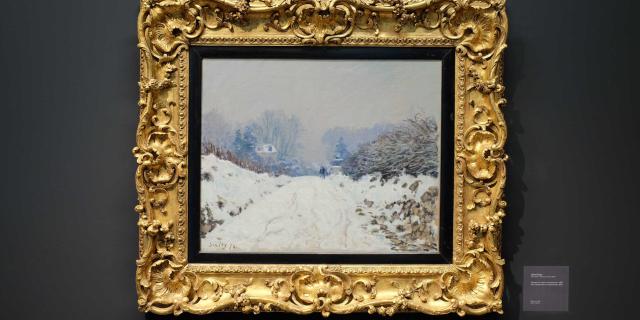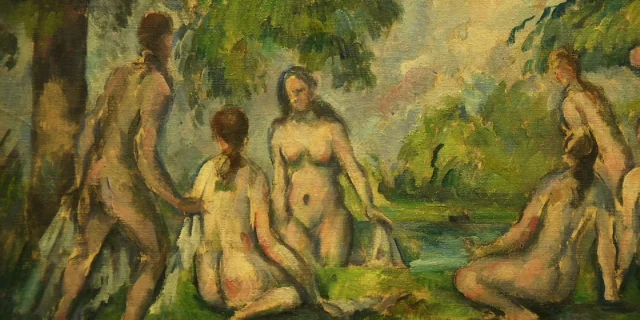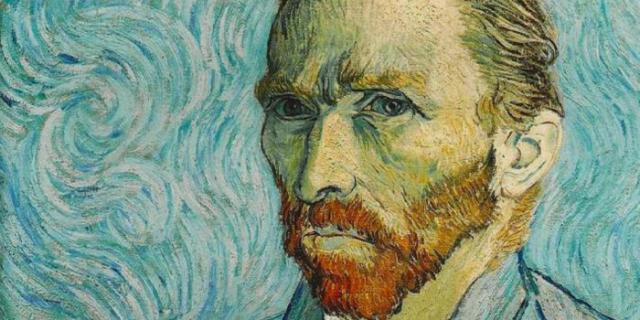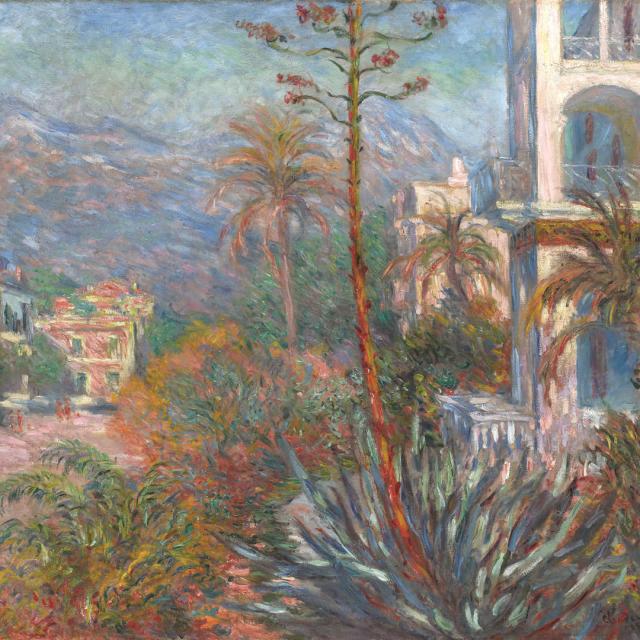 Van Gogh Nuit Etoilee Musee Dorsay Dist. Rmn Grand Palais Pschmidt
Van Gogh Nuit Etoilee Musee Dorsay Dist. Rmn Grand Palais PschmidtMeeting the Impressionists
in ProvenceStarry Night over the Rhône by Vincent Van Gogh (1888), exhibited at the Fondation Vincent Van Gogh in Arles, just a few hundred metres from where it was painted, is the flagship work on loan this year from the Musée d’Orsay in Paris. An avid fan of Jules Verne, the Dutch painter was fascinated by night skies and convinced that the souls of the deceased rose up to the stars: a passion explored by the Foundation this year with the Van Gogh et les étoiles exhibition. The show recreates the literary, scientific and artistic buzz around astronomy in the second half of the 19th century. The Fondation Vincent Van Gogh will be paying tribute to the artist’s oeuvre throughout 2024 and examining its influence on current artistic creation. The journey continues in Saint-Rémy-de-Provence, at the Musée Estrine, home to the Vincent Van Gogh interpretation centre. Don’t miss a visit to the Saint-Paul-de-Mausole cloister too while you’re visiting – it is there that Van Gogh was treated in 1889 and the site now features a reconstruction of his room.
Fondation Vincent Van Gogh – Arles – June 1st to August 25th, 2024
One of the leaders of the post-Impressionist movement, Auguste Chabaud was born in the South of France. The vineyard inherited by his parents in Graveson, between Avignon and Saint-Rémy-de-Provence, was a source of inspiration for him when he returned to Provence after WWI. After drawing and painting the banks of the Seine and the nightlife, cabarets and brothels of Montmartre, Chabaud devoted himself to rural scenes depicting animals, farmers, shepherds and Provencal landscapes. His work reflects the influence of the Fauvism movement, with its use of pure colours, along with pointillist touches evoking Seurat and Pissaro or the cubism of Cézanne, despite the fact that Auguste Chabaud maintained few ties with his contemporaries. Over time, his work was enriched with religious scenes from Provence and depictions of La Montagnette in the Alpilles. You can discover this multi-faceted Provencal artist at the Musée Auguste Chabaud in Graveson, where it all began…
 Auguste Chabaud Berger De Provence Musee Chabaud
Auguste Chabaud Berger De Provence Musee ChabaudVisitors pushing open the doors to the Musée Angladon in Avignon will discover the moving work of Alfred Sisley. This 18th century mansion house – Hôtel de Massilian – showcases Snow at Louveciennes (1874), one of the rare paintings by Sisley still present in Provence-Alpes-Côte d’Azur. A friend of Renoir and Monet, Sisley focused on the landscapes of Paris and its vicinity: Louveciennes, Bougival and Marly-le-Roi. Although he took part in the first three Impressionist exhibitions out of a total of eight, he was never truly recognized during his lifetime. Today, however, his canvasses rub shoulders with those of Edgar Degas (Two dancers (1880-1885) and A Woman Ironing (around 1874), Paul Cézanne (Still life with stoneware pot (1874) and Vincent Van Gogh (Railway carriages in Arles (1888)) at the Musée Angladon.
 Alfred Sisley Paysage De Neige Louveciennes Musee Angladon Collection Jacques Doucet
Alfred Sisley Paysage De Neige Louveciennes Musee Angladon Collection Jacques DoucetThe birthplace of Paul Cézanne, Aix-en-Provence pays tribute to its protégé at the Musée Granet, where a room is dedicated to him. Among the ten or so canvasses on show, the recently-acquired Portrait of Zola (circa 1862) paved the way for the monumental Bathers. A contemporary of the Impressionist movement, Cézanne frequented his peers in Paris, where he met and befriended Camille Pissaro, who introduced him to the Impressionist style using little touches of colour. But he gradually moved away from the Impressionist movement and Paris, preferring his Provencal homeland and Sainte-Victoire mountain, which he painted over and over. Although he went on to develop his own style, he continued to share the Impressionist passion for depicting light. The Musée Granet exhibits various works by Impressionist artists including Claude Monet (Leicester Square (1901), Edgar Degas (Two Women Bathing (1895) and Vincent Van Gogh (Bouquet of Flowers (1886)), alongside paintings by Cézanne.
 Les Baigneuses de Paul Cézanne au Musée Granet, Aix-en-Provence
Les Baigneuses de Paul Cézanne au Musée Granet, Aix-en-ProvenceWhile Impressionism spread throughout Provence in the second half of the 19th century, the Provencal school, personified by Emile Loubon, also began to make its mark. Focusing on the natural scenery of the South of France, the Provencal school opposed academic art and presented itself as an alternative to Impressionism, considered at the time as a “very-Parisian” movement. This year, the Musée des Beaux-Arts in Marseille is welcoming the exhibition Peindre Marseille, 1853-1878. Une autre modernité, exploring both schools’ visions of landscape painting. Visitors will be able to admire the View of Marseille from Les Aygalades on market day (1857) by Emile Loubon and The Gulf of Marseilles seen from l’Estaque (1878), a work by Cézanne visibly influenced by Loubon, on loan from the Musée d’Orsay together with Paul Guigou’s La Lavandière (1860). Other exhibits include paintings by Monticelli and Engalière, part of the city of Marseille’s heritage collections. The Musée Regards de Provence is also hosting an exhibition entitled La Collection – Ses 25 ans, running until April 14th, 2024, shining a spotlight on Provence’s post-impressionist, fauvist and expressionist landscape painters including Jean-Baptiste Olive, Félix Ziem and Louis-Mathieu Verdilhan. Another must-see: the permanent collection at the Cantini Museum, showcasing works by Othon Friesz, Raoul Dufy, André Derain and Paul Signac.
Musée des Beaux-Arts – Marseille – May 24th to September 4th, 2024
Musée Regards de Provence – Marseille – Until April 14th, 2024
 Cezanne Musee Dorsay Dist Rmn Grandpalais Pschmidt
Cezanne Musee Dorsay Dist Rmn Grandpalais PschmidtSince 1939, the Musée des Beaux-Arts in Draguignan has been the proud owner of Child With a Biscuit (1887), a portrait by Auguste Renoir depicting his son Jean as a baby. For the 150th anniversary of Impressionism, the museum is showing another masterpiece by Renoir, on loan from the Musée d’Orsay: Study. Torso, Sunlight Effect (circa 1876). The canvas garnered attention at the second Impressionist exhibition in 1876, intriguing art critics with its singular blue and yellow shades. Study. Torso, Sunlight Effect will be joining the museum’s 20th century room for the exhibition Le printemps impressionniste de Monsieur Renoir, highlighting the artist, his role in the Impressionist movement and his in-depth knowledge of the art world.
Musée des Beaux-Arts – Draguignan – March 9th to June 23rd, 2024
 Renoir Museedorsay Distrmn Grandpalais Pschmidt
Renoir Museedorsay Distrmn Grandpalais Pschmidt













